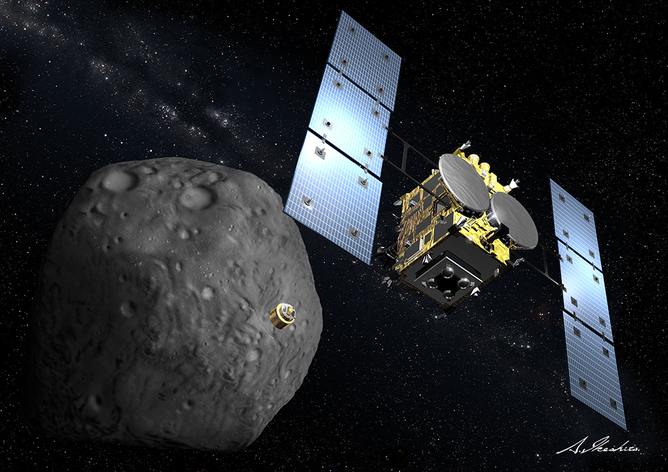The Comet 67P Churyumov-Gerasimenko was visited in 2014 by both the European Space Agency’s Rosetta orbiter and the Philae lander, making it the top science story of last year. Now, the ESA and NASA are continuing to observe the comet as it makes its orbit throughout the solar system.
The Rosetta – a name that the ESA uses to exclusively refer to both spacecraft – made its landing as 67P orbited closest to the sun – a target of interest as the probe would be able to study the comet as it thawed, moving closer to the sun, particularly the nature of gasses and dusts it emits during the thawing process. They were once thought of as the “dirty snowballs” of space – composed largely of ice and dust. While that remains true, the data provided by Rosetta in recent months has led scientists to suggest that a better metaphor is deep fried ice cream – with a hard outer crust that gives way to a cold interior tightly packed underneath.
Studies of 67P, however, were designed with the purpose of helping astronomers to understand more about the beginnings of the early solar system – and possibly other fields of science as well. Because they contain ice and other amino acids, they are suspected to have played a role in jump starting life as we know it throughout the universe. So what are comets exactly? Most astronomers consider them to be the remnants from a time in which the solar system was just ice and rock, floating chaotically through space, 4.6 billion years ago. Much of this material eventually congealed to form planets and moons after a series of violent collisions, but there are still plenty of parts left over, floating freely through space.
While comets go through processes of thawing and freezing depending on their relative closeness to their host star, the full nature of these processes is still extremely unpredictable – particularly when it comes to their changes in brightness. Take, for example, the Comet ISON, which astronomers thought would be a prominent comet (easily visible to the naked eye from the Earth sky) at the end of 2013 and into early 2014. Instead, the comet fell apart after passing the sun in November 2013, before anyone was able to enjoy the view.
67P was first spotted in 1969, and given its somewhat difficult to pronounce name in honor of the two Ukrainian astronomers Klim Churyumov and Svetlana Gerasimenko who first observed it outside the Institute of Astrophysics in Alma-Ata (now named Almaty), in Kazakhstan. They stumbled across it quite by accident, as they were seeking out the Comet 32P/Comas Solà, which had been discovered in the 1920s. The comet is of a “periodic” nature – making regular runs through our inner solar system. What’s more is that the astronomers hadn’t even realized they found anything new when they first discovered it, as observations then were recorded on photographic plates to be developed following each observing session. The night they first saw 67P – the plate containing it had been underdeveloped.
According to the ESA: “As Svetlana was processing one of these plates on 11 September, she realized she didn’t have much solution to develop the plates, but decided to process that one anyway, before preparing a fresh solution. As a result, that plate was underdeveloped. Svetlana almost threw the defective plate away, but she didn’t. After all, a tiny splotch of light was visible at the center, and they thought it was comet 32P/Comas Solà.”
It took a month until they realized they had discovered a new comet.
The duo was still active in 2015, and saw their work pay off as the ESA prepared its mission to 67P in 2004, after a failed previous attempt to launch a probe to Comet 46P/Wirtanen the year before. The Rosetta took off for its destination on March 2, 2004, riding aboard an Ariane 5 rocket. It sent several slingshot maneuvers (three of them near Earth and one past Mars) before spinning off further into the solar system. Before reaching its destination it snapped off some long-distance images of asteroids, comets and even briefly investigated the atmosphere on both the planets Venus and Mars respectively.
It went into hibernation in June 2011 and was revived in January 2014 as it made its final maneuvers, successfully arriving in August 2014 and releasing the Philae lander in November 2014. While the initial landing was a success, the Philae was not quite so fortunate, tipping on its side as it drifted across the comet, into a zone where there was a lack of sunlight, pushing it into hibernation, although the ESA team remains hopeful that exposure to the sun this spring may revive it.
In the samples of tightly packed dust they have taken from the comet, which appears to compose the majority of it, there have already been traces of organic molecules found, making it possible that collisions with comets like 67P could leave behind ingredients necessary for life. Researchers at the ESA have also found traces of warm water on the comet, which is drinkable but not quite like the water on Earth, made from a heavier isotope of hydrogen than what we’re used to.
|
James Sullivan
James Sullivan is the assistant editor of Brain World Magazine and a contributor to Truth Is Cool and OMNI Reboot. He can usually be found on TVTropes or RationalWiki when not exploiting life and science stories for another blog article. |

